Paper Bag Sketches
Had two paper bags laying around on my desk. Decided to draw flowers on one and our friend Joe on another- using Uni Posca paint markers.


A blog about writing, sketching, running and other things
Had two paper bags laying around on my desk. Decided to draw flowers on one and our friend Joe on another- using Uni Posca paint markers.


There were a few Posca paint marker sets on sale while I was in London, so I bought two sets to play with. Here’s a quick sketch of a planter near the Tel Aviv port, done with fine Posca paint markers on a paper bag that held sweet peppers before I reused it.
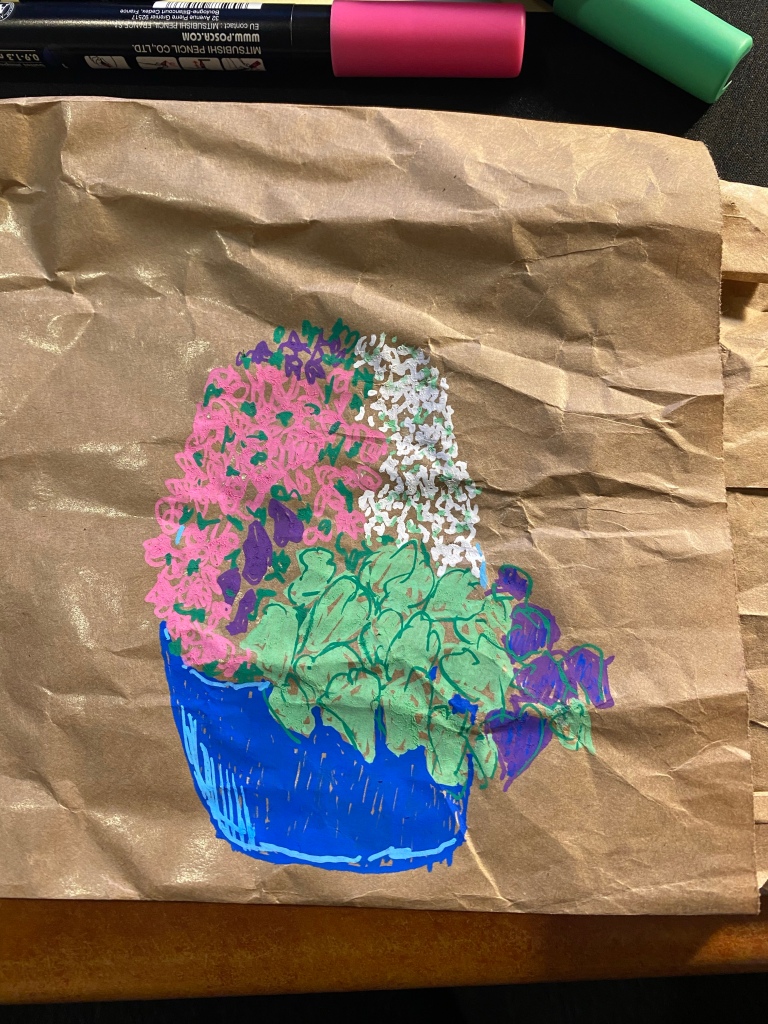
Quick sketch of people making cocktails in the dark. Uni-ball Jetstream Edge 0.38 on a Stillman and Birn pocket Alpha.


I’m not a fan of ballpoint pens. Their refills tend to streak and glob, the ink they use isn’t ass dark or vibrant as their gel ink and rollerball counterparts, and something about them (probably the lightness and inconsistency of the refill) makes me grip them with “the grip of death,” which inevitably brings on hand cramps and pain. They are, however, useful at times, so I am constantly on the lookout for new and better ballpoint pens and ballpoint refills.
Enter the Uni Jetstream Edge, a ballpoint pen with a strikingly modern design and the world’s first 0.28mm ballpoint refill (there’s also a 0.38mm refill option but I won’t review it here).

I love the design of this pen. The body is plastic, but the grip area is metal and relatively wide, which makes for a very well balanced pen. The bent wire shape of the clip adds to its modern and clean aesthetic, and I like that chose to make it red and not black or silver in the white edition of this pen. The clip looks like it would be a fun and springy fidget tool, but it’s quite inflexible and immobile. That’s great if you plan on using it to clip it to a shirt pocket, but the unusual clip shape means that clipping it to paper will likely crumple and even tear the paper. I don’t normally clip my pens to things, so that’s not going to be an issue for me, but YMMV.

The Jetstream Edge grip section is metal and round, unlike the plastic, faceted pen body. There are grooves carved into it that make it comfortable to hold, and the refill sits very snugly in the pen sleeve. This is a pen that’s not going to rattle while you write.

The 0.28 mm Jetstream ballpoint refill has been designed so that the tip won’t suffer the usual “bent out of shape the moment you breath too hard on it” fate of the Pilot Hi-Tec-C refills. Its sturdy but still keeps a tapered, fine tip, which means that you can use it with rulers and templates if you so desire.

The refill the Jetstream Edge uses is the SXR 203-28 for the 0.28 mm or the SXR 203-38 for the 0.38mm tips size, although it appears that can also accept the Uni SXR-80 line of refills used for Uni-ball’s multi-pens. If so, that could open a wider range of refill colours and tip sizes.
The original, SXR 203, refill is very slim, which would have been problematic if it was a gel ink refill (you’d have written it dry in a day), but shouldn’t be a problem with a ballpoint refill. That being said, I doubt that this refill will last as long as a standard Parker one, not to mention the Caran d’Ache Goliath.

While Uni-ball brags that the Edge uses the first 0.28mm ballpoint refill in the world, there are other brands that use ultra fine ballpoint refills not far from it in size. My Midori (now Traveler’s Company) Brass Ballpoint pen has a refill that is around that size, so I thought I’d compare the two.

Here are the pen tips side by side. The barrels, grips and cones are very different but the refill tups are very much alike.

Below you’ll find a writing sample of the Jetstream Edge, and one of the Midori/Traveler’s Company Brass Ballpoint for comparison. Perhaps unsurprisingly, being a Jetstream refill, the Edge’s refill is better than the Midori’s even though it is slightly thinner. It lays down a more consistent and slightly darker line (although nowhere near as dark as a gel ink pen’s line).

I wrote seven full A5 pages with the Jetstream Edge, to see how consistent the line is over time, and to see if it would cause hand cramps after prolonged use. While I was writing I made a concentrated effort to keep a light grip on the pen. The barrel design helped with this, and the pen’s light weight and front heavy balance made it nice to hold and write with. But the Jetstream Edge is a pen with a sweet spot, not unlike certain fountain pens. Angle it too much and the refill starts to skip, so you need to write with the pen as vertically as possible. That slightly awkward writing angle may have been the cause of my hand cramps, but whatever the cause may be, this is not a pen that will work for long writing sessions for me.
So, do I recommend the Uni Jetstream Edge? If you’re a ballpoint fan and an ultra micro tip fan, then yes. Otherwise, there are cheaper and better ballpoint pens out there, even within the excellent Uni-ball Jetstream line.
Will I be using the Jetstream Edge? Yes, although not for long writing sessions. I love the line it lays down, and I like the aesthetic of this pen. Then again, I’m a fan of the Pilot Hi-Tec-C…
I am a huge fan of the Uni-ball Signo line, and the Signo RT 0.5 is my favourite gel pen body and my favourite gel ink refill (UMR-85N). In second place is the Uni-ball Signo DX (UMR-1 refill) and its less common brother: the Uni-ball Signo Needle, which is basically a Signo DX with a needle tip instead of a cone tip.

Like the Uni-ball Signo DX the Uni-ball Signo Needle isn’t as commonly found in the wild of stationery stores as the Pilot G2 or Pilot Hi-Tech-C. It does, however, come in a wide variety of colours, and unlike the Pilot G2 doesn’t blob and smear like crazy. It also has a needle tip that doesn’t wither the moment you look at it, unlike the Pilot Hi-Tech-C. It’s a workhorse needle tip gel pen with an excellent refill that doesn’t dry out even after spending years on your desk, and allows you to use it without worrying about babying its fragile needle tip.
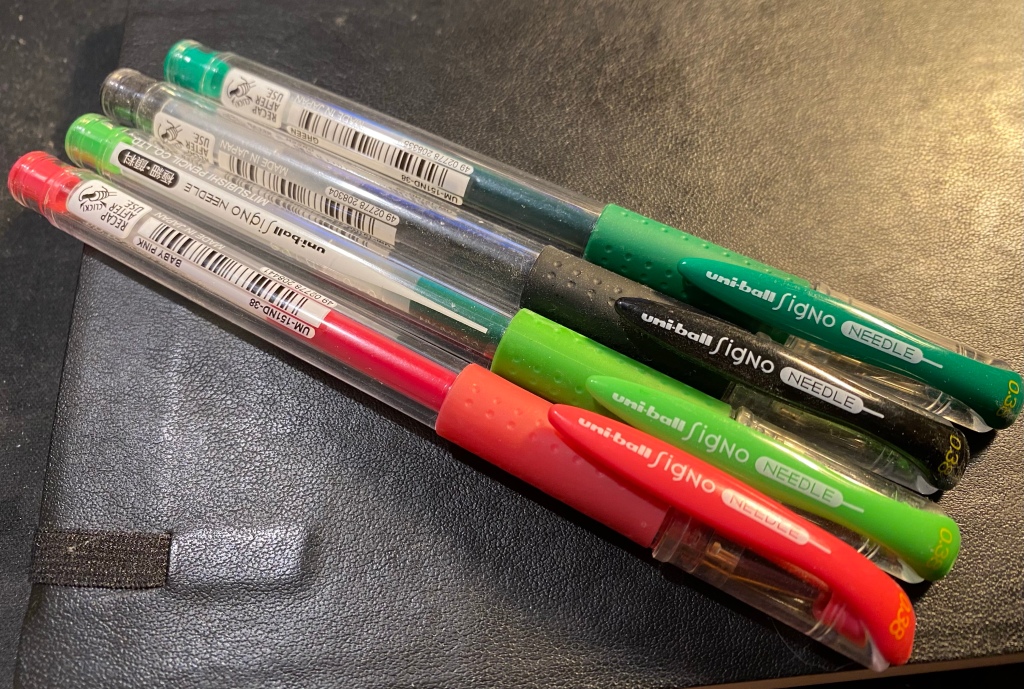
I love the Pilot Hi-Tec-C but I’m well aware that I have thrown more of them away than I have been able to use (the tip bends, the ink dries up and the pen no longer writes, there are “bubbles” in the refills of the even more delicate multi-pen variants of this pen). I’ve yet to have thrown a Uni-ball Signo pen away, needle point pens included. The magic happens in the tip design, which isn’t a two part deal like in the Hi-Tech-C but rather is a DX tip that has been shaped into a needle point, as if someone had taken it between two fingers and squeezed it to form a needle tip. The result is a tip that is stronger with no weak points that are prone to bending.
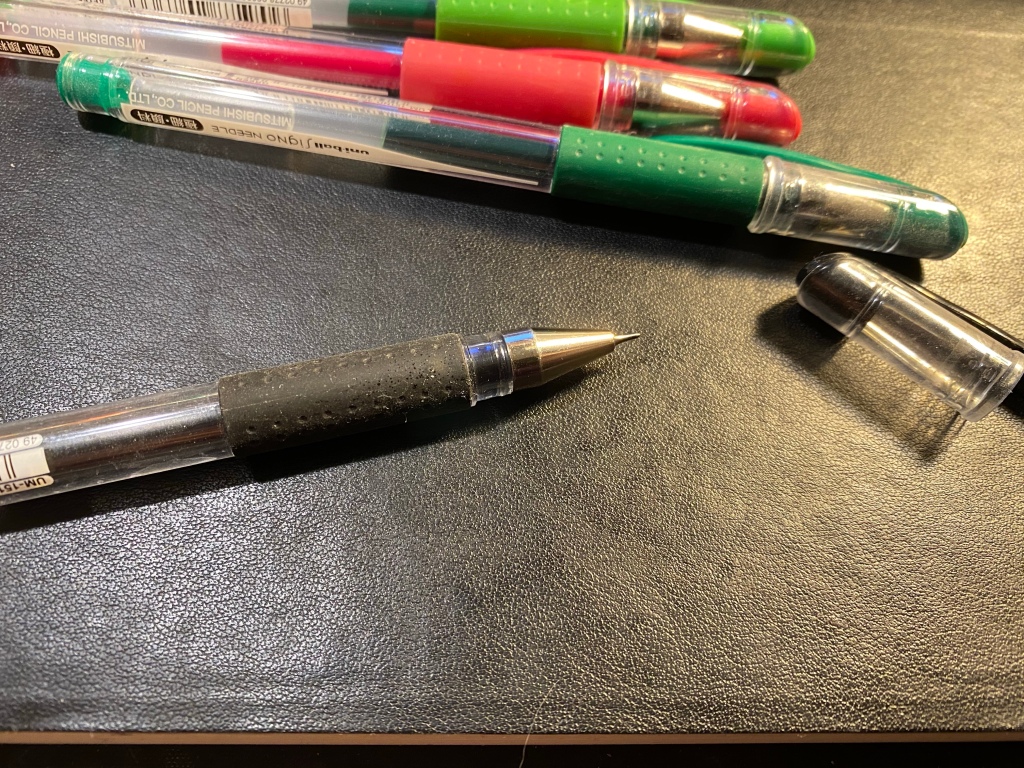
You can see the difference between the Signo Needle tip on the top, and Signo DX tip in my Spoke pen on the bottom. It’s basically the same tip just tapered more acutely.

In terms of refills, the Signo Needle uses a UMR-1ND refill, which is the same as the Signo DX’s UMR-1 refill just with a different tip attached. This means that there are very few machined pens on the market that will fit the UMR-1ND refill because of the way the front of the refill is designed. However…

The Signo Needle refill does fit the Spoke pen! This is a fun bonus of them having the same refill design as the DX (minus the tip). So now not only can you have a reliable needle point gel ink pen with a variety of refills, it will also fit one of the best machined pens on the market (at least in my opinion).

I will point out that there is a tiny gap between the pen tip and the grip if you do use a UMR-1ND refill in the Spoke pen, however, the refill doesn’t wiggle in the pen and the gap doesn’t extend into the pen body – it’s just an aesthetic thing.
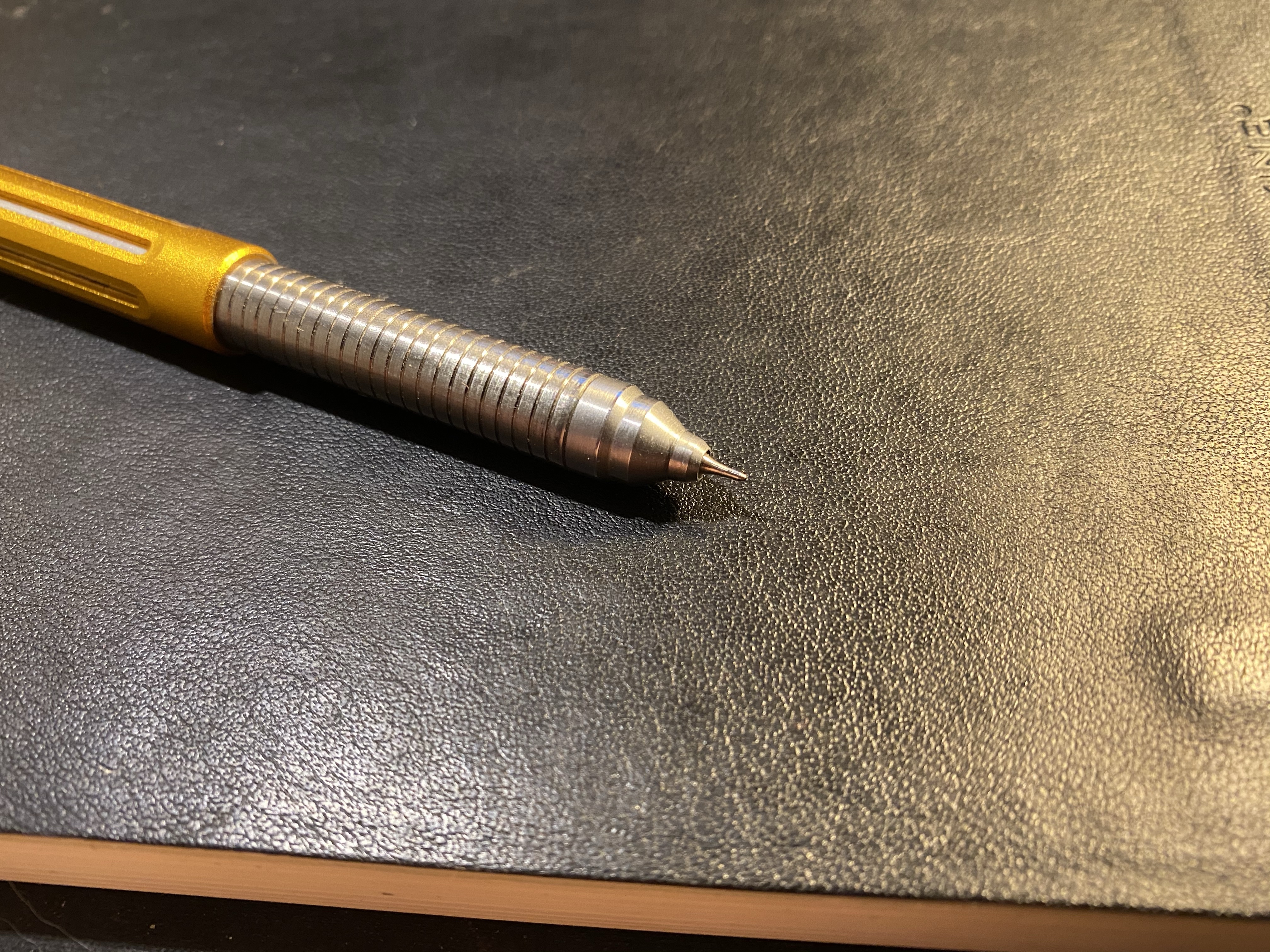
Here’s a writing sample with the Signo Needle 0.38. As you can see the lines are crisp and consistent even though I’ve had some of these pens lying around my desk for years. They are a tiny bit wider than the Hi-Tech-C 0.38 lines (just as the Signo DX 0.38 lines are wider than the Hi-Tech-C but thinner than the Pilot G2 0.38).

If you’re looking for a needle tip gel ink pen and are tired of throwing out broken Hi-Tech-Cs (or don’t like their somewhat spartan pen body), give the Signo Needle 0.38 a chance. It may be slightly more expensive than a Hi-Tech-C, but it will ultimately turn out to be cheaper because you’ll have a pen that you can actually use from start to finish.

First review of the year! I bought the Uni Pro M9-552 mechanical pencil a while ago in London, I believe. Never having heard of it before, and noting that it was an inexpensive drafting pencil, I decided to give it a try. I wasn’t disappointed: the Uni Pro M9-552 has a terrible name, but it’s a very good drafting pencil AND a very good mechanical pencil, which is not the same thing.

The Uni Pro has a plastic body, a knurled aluminium grip and an aluminium cap and clip. This makes for a light pencil that is weighed towards the tip, which is what makes this a good mechanical pencil and not just a good drafting pencil. It’s very comfortable to hold and write or draw with, even for long periods of time, because of the weight distribution and the knurling on the grip. The knurling provides excellent grip without cutting into your hands.

Like all drafting pencils, it has a long lead sleeve and a lead grade indicator. I like the touch of colour that it provides to this otherwise very utilitarian design. The cap has the lead width, 0.9, engraved into it, and under it is the usual refillable eraser. It will do in a pinch, when you don’t have a block eraser around and have very little to erase.
This isn’t a lead review so I’m not posting a writing sample, but I will say this – if you haven’t tried writing or drawing with a 0.9 lead mechanical pencil, I recommend giving it a go. You get most of the line variation and expressiveness of a woodcase pencil, but without having to stop and sharpen it all the time.

The Uni Pro M9-552 is a good choice of drafting pencil, with its light weight making it a good choice for people with small hands or those that are looking for a drafting pencil that can also serve as a mechanical pencil (i.e. a daily writer). The Uni Pro 552 series also includes a 0.5 pencil (with a red lead grade indicator), 0.7 pencil (blue indicator), 0.3 pencil (yellow indicator), and even a 0.4 pencil (orange indicator, at a rare lead width).

My brother’s cat was not amused when he tried to take his laptop back from her.

Sketched with a non-photo blue Pilot Color Eno 0.7 mechanical pencil and inked with a Pentel GFKP Sepia, Uni pin 0.5 sepia fineliner and Zig Mangaka 0.8 fineliner (for the writing) on an Artcoe Frisk Sketch Book. Could have done it all with one pen and no underdrawing but I’m experimenting with my setup at the moment.

Black erasers have become more common in recent years, with the Boxy perhaps being the most well known of the bunch. I have a few that I use regularly, and a few that just lounge in my stationery drawers waiting to be used. As I’m streamlining my sketching kit and the boxy is now the eraser I carry in it, I decided to test it out against the competition, starting with other black erasers.
Here’s the lineup:
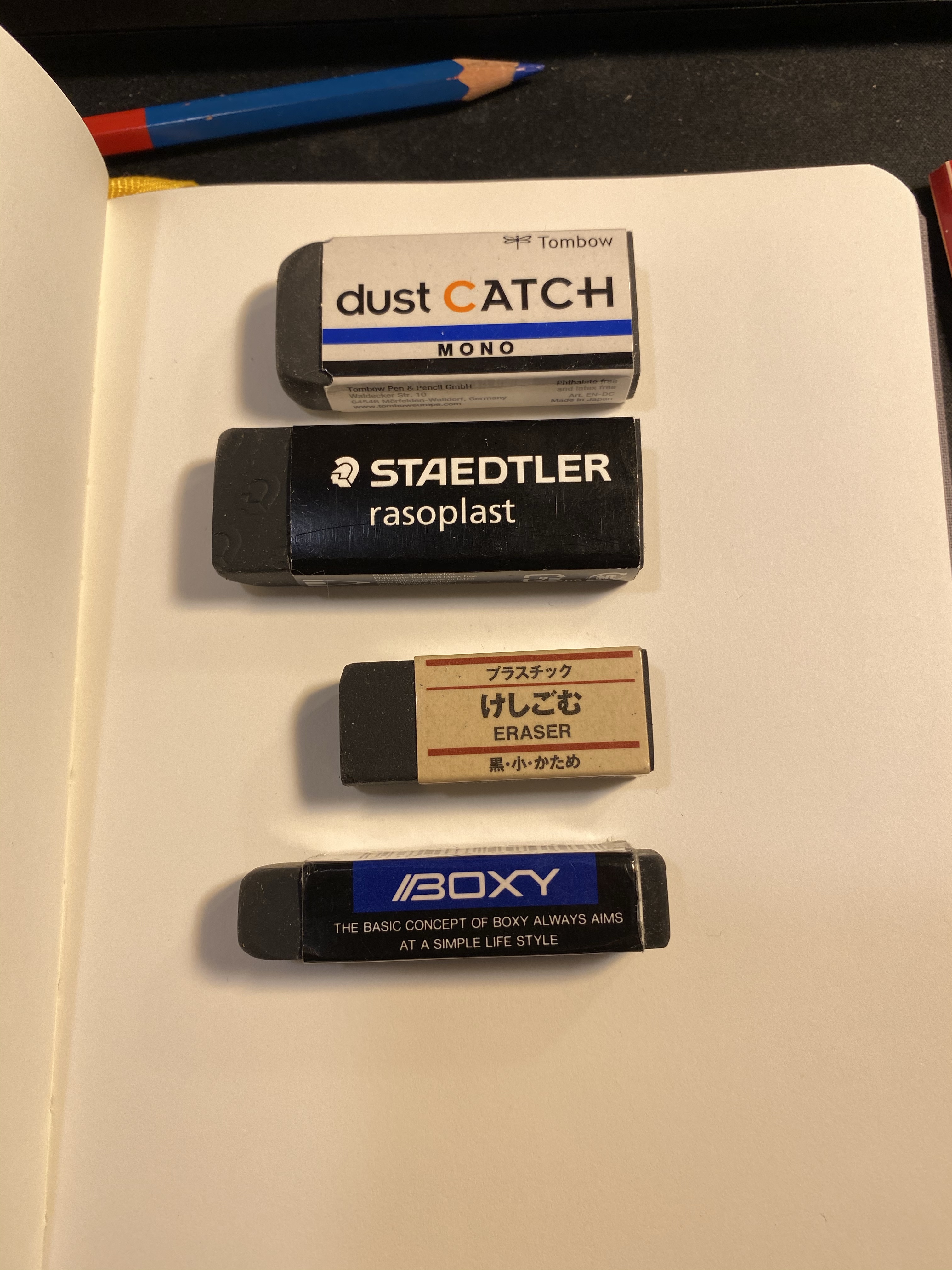
In terms of price they’re all around the same price range with the Muji eraser being the cheapest of the bunch, and the dust catch and boxy being on the more expensive side of things.
I took out my Baron Fig Confidant, since I do all my pencil tests on it, and scribbled in it in a variety of pencils and even using a Caran d’Ache red blue pencil, though I don’t expect regular erasers to do well with coloured pencils.
The pencils that I used were the Blackwing 811 (a darker, softer pencil), a Viarco 3500 No. 2 (a standard HB pencil) and a vintage Eagle “Chemi-Sealed” Turquoise H pencil. These seemed like a fairly representative bunch of general writing pencils, at least in terms of graphite behaviour. Though I did later check them for art use, these erasers are meant to be used when writing more than when drawing.

I did a single eraser pass on the left hand side of the page, and on the right side I split each scribble into two and tried to erase it completely (leaving an untouched graphite barrier in between each side).
Then I tried to erase the coloured pencil, which I wasn’t expecting much success in, and here are the results:

A closeup on the one pass side. You’d normally not erase this way, but it does give a good indication of how good the eraser is going to be:

A closeup on the H pencil one pass attempt. I deliberately pressed down on the H pencil, because from my experience H pencils are easy to erase when you apply little or no pressure to them, but they’re pretty tenacious if you apply normal or strong pressure on them.

Here’s the split scribble test above and the H scribble test below:

Finally the Caran d’Ache red/blue eraser test:

At this point I was ready to give the victory to the Boxy, with the Mono Dust Catch a pretty close second, the Staedler Rasoplast in third place and the Muji eraser trailing behind. The Boxy and the Dust Catch also had the easiest “eraser crumbs” to clean (long threads of the stuff, easily brushed aside), and the Muji had the smallest and the worst. None of the erasers damaged the paper, which perhaps isn’t surprising considering that they’re all pretty soft.
I’d also point out that none of these erasers are what I’d call “best”. They’re good erasers, but even the boxy left graphite ghosts behind. There are better erasers on the market, but these in general behaved better than average (even the Muji), and the Boxy and Dust Catch are pretty good. They held up well even against the Caran d’Ache red/blue pencil, which surprised me.
Even though these aren’t “art” erasers, I decide to try to draw some doodles in pencils, ink them with a fine liner and check how much ink each of these erasers lifted.

Here’s the inking. You can see the pencil marks beneath, and I waited for the ink to completely dry before trying to erase the underdrawing.
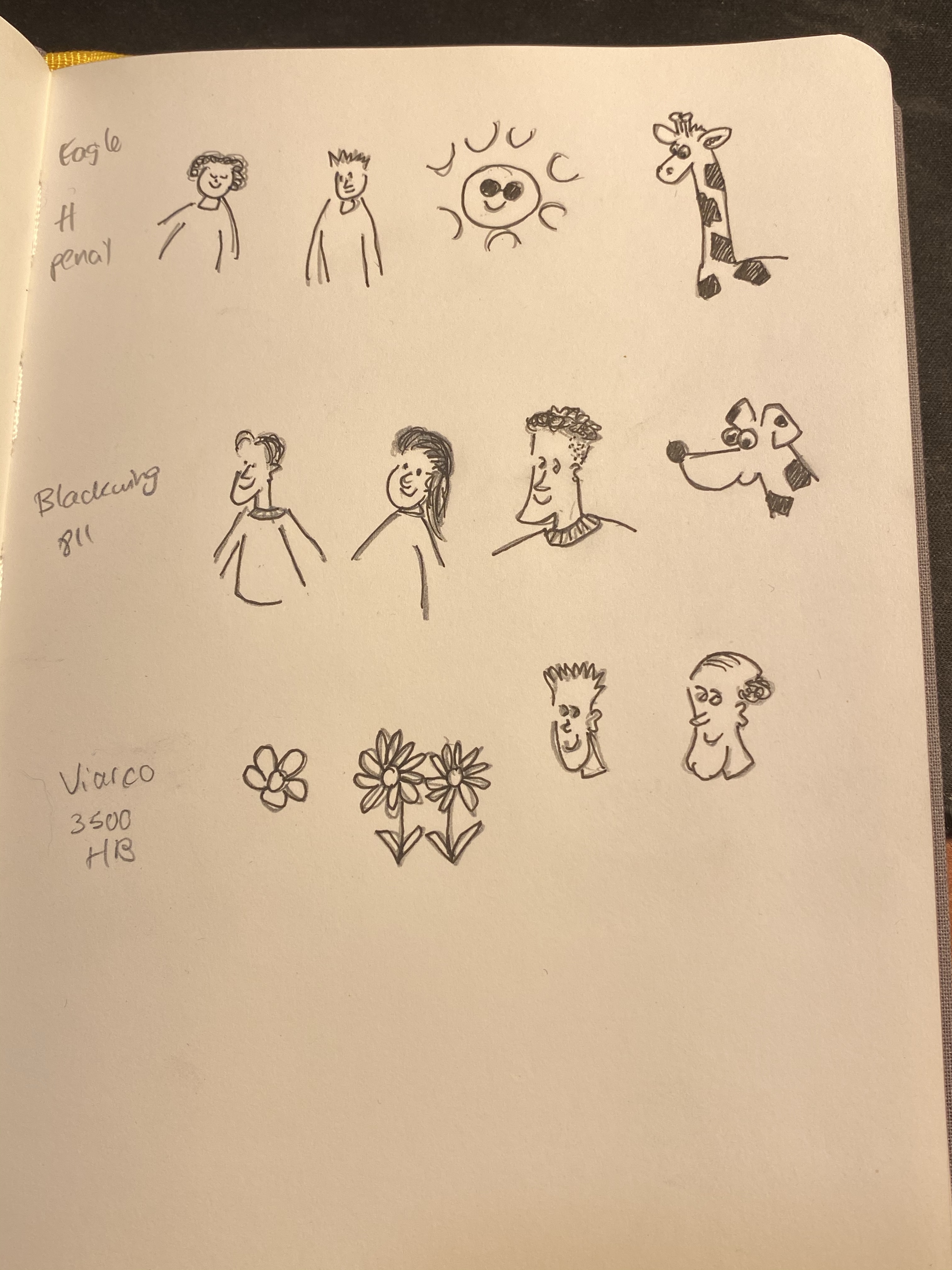
The results were “ravishing” as to be expected:

You can look at the closeup below and see just how much ink was lifted. These are all terrible for art use, which again, isn’t surprising. I drew an ink line for reference under these, just so you can see how much ink was lifted. Also the top line of left hand dude’s sleeve wasn’t erased so you can compare that too:

The Muji erased faired the best at this part of the test, although I still wouldn’t recommend using it to erase underdrawings.
Of the four erasers that I tested, the Boxy and Dust Catch are the best, and of these two the Boxy is the one I would choose, because of its compact size and its slightly better performance. None of these erasers are terrible, but if you’re investing in a good box eraser (and you should) the Boxy is definitely one to consider.
And why are these black? Presumably to not show dirt, though I find that both frivolous and counterproductive. If the eraser shows dirt, then you know that may need to clean it on a bit of scrap paper before using it, so that it won’t transfer that dirt onto your clean paper. However, I suspect that the real reason is that black erasers just look cool, and the rest is just plain marketing.

The 5th of July is apparently mechanical pencil day, which is something that Cult Pens started most likely out of promotional reasons. I’m all for celebrating what ever little things we have because life in general and mine in particular sucks pretty badly now, so I’m jumping on the bandwagon and posting two mechanical pencil reviews.

The first mechanical pencil is actually a drafting pencil, and it’s the excellent Pentel Graphgear 1000. I actually enjoy writing with the Graphgear more than I enjoy writing with my Rotring 600 and 800 (gasp!).

The Graphgear is lighter than my Rotring pencils, its knurling is less harsh on the fingers particularly because of the (non-latex) pads it sports, and the retracting mechanism means business.

It also helps that this is a well designed pencil, a beautiful writing tool to use, and whoever thought of creating different colour schemes for different lead sizes and incorporating that colour subtly over the pencils should get an employee of the month prize at the very least.

The retracting mechanism for the Graphgear sits in the clip, and works beautifully and makes the most satisfying “chunk” sound in the world. It retracts the pencil tip into the pencil body, ensuring that the lead doesn’t break and you don’t get stabbed while carrying your pencil around. This is a must-have feature for drafting pencils (together with the knurled grip, lead pipe, and lead hardness indicator), and it is done to perfection here. The only minus is the cutout below the clip that tends to collect pocket lint while being carried.

A click on the pencil cap extracts the lead sleeve once it has been retracted, and you press on the clip to retract the lead pipe, which is something that you’d do anyway to clip the Graphgear to you pocket, so this is a very intuitive pencil to use.

The grip is superb: the Graphgear won’t accidentally slip from your hand, and the knurling won’t dig into either, even if you have a “grip of death”.

The tip of the pen cap has a lead size indicator, in this case 0.7, and right above the grip you’ll find a lead grade indicator.

The Pentel Graphgear 1000 isn’t a cheap mechanical pencil, but if you are looking for a drafting pencil to use for long periods of time, or you’re looking for a mechanical pencil that’s a cut above (except for the Uni-Ball Kuru Toga), I highly recommend this pencil.
Bonus tip: If you’re starting out in watercolour on location or urban sketching, get a pencil like the Pentel Graphgear in 0.5 or 0.7 and some H leads and use that for your preliminary sketches. Even if you don’t erase them, they’ll disappear behind the washes.
Now for the second mechanical pencil, which is also a unique beast: the Retro 51 Tornado Pencil.

There are two things that are unusual with this mechanical pencil: it uses a 1.15 mm lead, and it’s shaped like a Retro 51 Tornado rollerball. That means that this is a bigger than usual pencil that uses a bigger than usual lead. Is it any good?

It depends. I’d skip using it for drawing or sketching, because at that lead size either go the 2mm lead holder route, or stick to woodcase pencils. It is, however, a fun object to have around, and it’s pretty nifty for sudoku and crosswords. The lead size is perfect for that, creating a pretty bold line even on sub-par paper while still giving your the option to erase it.
Have a delightful mechanical pencil day, and when in doubt, Kuru Toga.

I haven’t bought a fountain pen on eBay in years, but when I decided to celebrate completing a six month intensive DevOps course, I headed out to eBay in search for the Rotring 600 Levenger rollerball. Yes, you read that correctly, I was looking for the Rotring 600 rollerball, not the fountain pen. I love the design of the Rotring 600 Levenger pens, but I thought that there was zero chance that I’ll manage to snag a good quality fountain pen, not to mention a fountain pen and rollerball set, so I decided to focus on the cheaper to obtain rollerball. As it turned out, I landed on an estate sale Rotring 600 set, and managed to get a Rotring 600 Levenger fountain pen and rollerball in great condition for a pretty good price.

The Rotring 600 Levenger pens aren’t flashy. They both have metal hexagon bodies with knurled ends and the classic Rotring red rings on the cap ends. The cap ends and the grip and the pen finial and round, and the pen body and cap are hexagonal, and somehow the transition between these two shapes is perfect and seamless. Industrial design at its best.

The fountain pen cap snaps into place with the help of the two silver protrusions on the knurled grip section. These protrusions don’t get in the way while writing, no matter how weird your pen grip is, and the section itself is very comfortable to hold. The knurling isn’t as dense as on the Rotring 600 mechanical pencil, and it is smoothed over so it doesn’t dig into your fingers. It provides a secure grip, while giving the pen the traditional Rotring look.

Because of the silver protrusions the pen cap snaps very securely into place. The fountain pen came with no converter, just unbranded short international cartridges, but it was easy enough to take the converter off my Super5 pen and use it here. The nib grade is indicated on the pen cap, which is what you’d expect on a drafting pencil. I like that oh so Rotring touch.

The Rotring 600 fountain pen comes with a steel nib that’s shaped a lot like a Lamy Safari nib. It’s stamped with Rotring’s logo on one side, and the nib grade on the other.

The nib is smooth and a lot of fun to write with, but it’s on the wider (European) side of fine. A 0.7 mm width line. Check out that grip section design:

The rollerball has a blue indicator, presumably for the colour of the ink refill inside. By the time I got it the refill had dried out, and so I replaced it with my favourite refill, the Uni-ball UMR-85N gel ink refill. This is the reason I bought the set and I couldn’t be happier with my purchase. Just look at it:

That’s so sleek and so clever, and I have no idea why they stopped producing them. Side by side you can see that the knurling on the fountain pen is slightly more pronounced. You can hardly feel the difference when in use, but I thought that it’s worth pointing out.
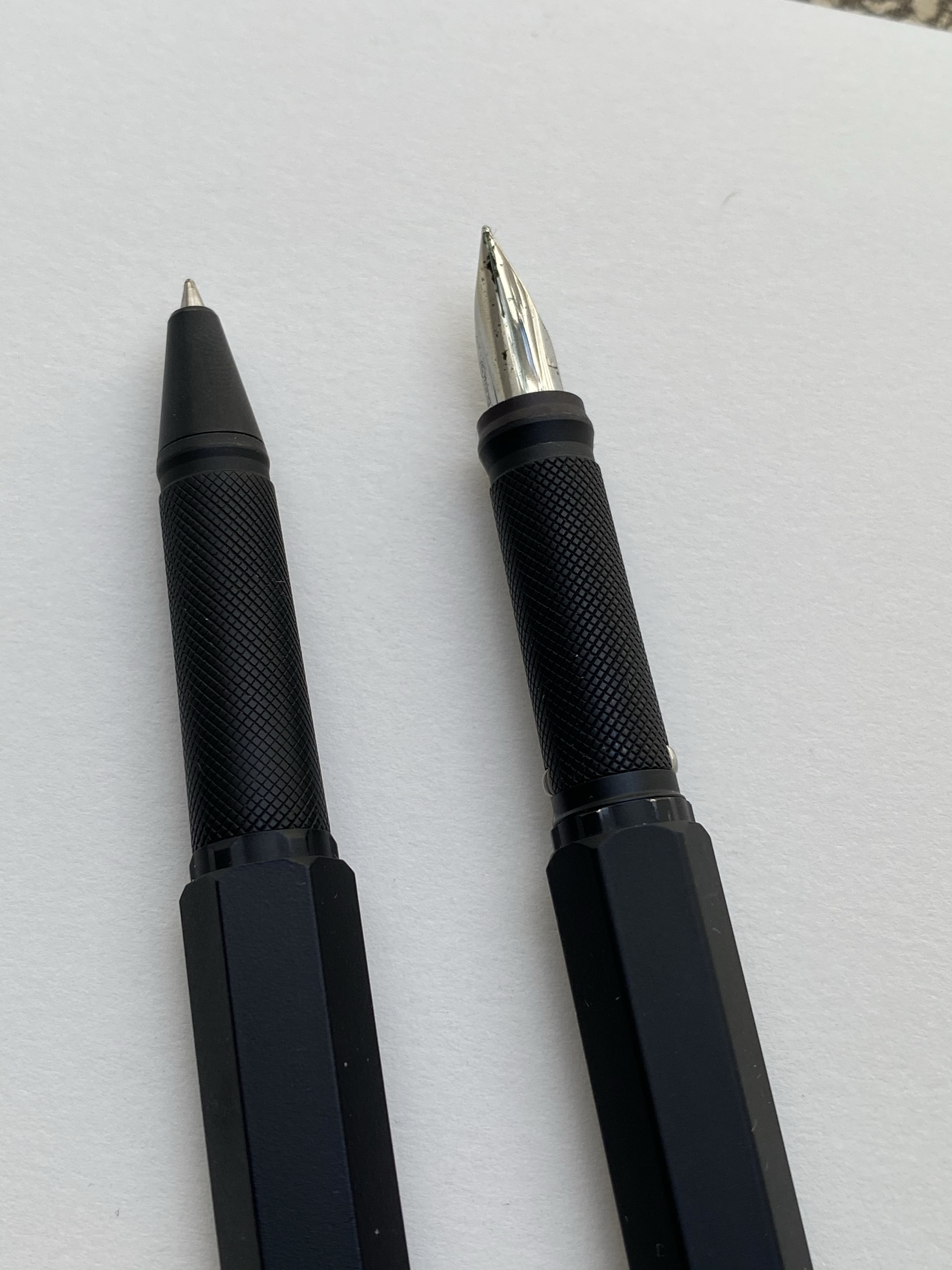
And here is that glorious nib in use, with a quick sketch of the Albert Memorial in London. The ink is Sailor Jentle Ink Epinard, which is a fun ink to sketch with an a green ink dark enough that you can sneak it into office use (not that anyone would notice or care right now).

It’s been a tough time, and a long and challenging six months course, but I couldn’t be happier with my “reward” for finishing it. If you run across a Rotring 600 rollerball or fountain pen at a reasonable price, by all means, buy them. The design on these pens is the kind that belongs in museums it’s so good, and they are a lot of fun to use too.
Rotring, if you’re listening, bring these back!